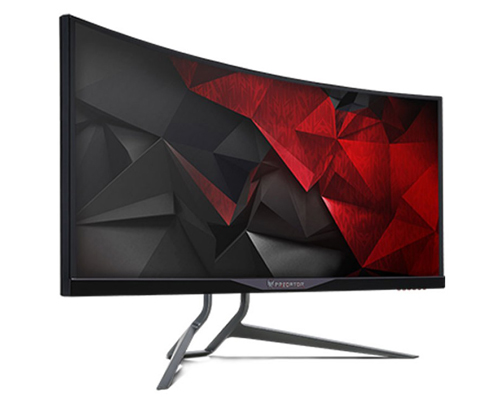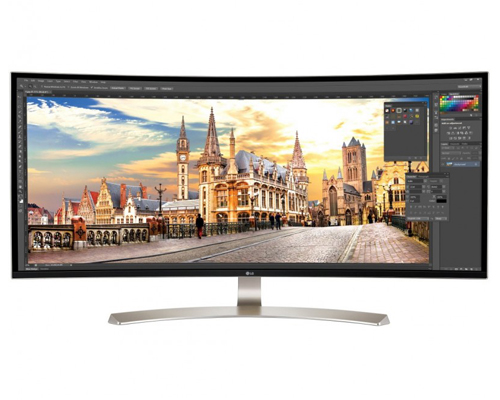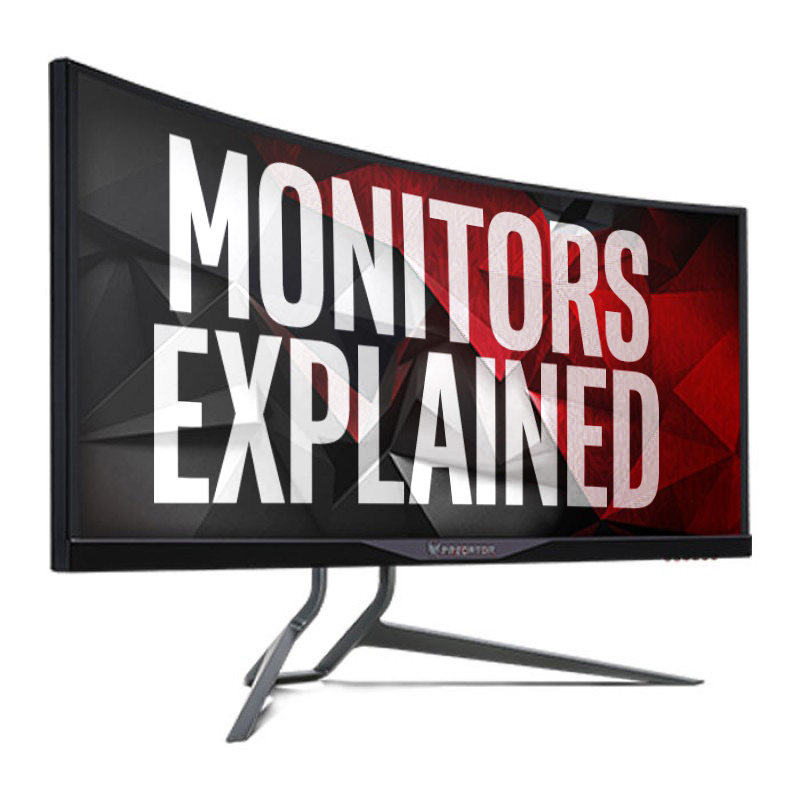No gaming, home or office PC is complete without a monitor, and there’s never been more choice. Gamers can pick from sync-equipped screens with curved panels, while movie buffs can choose widescreen monitors with incredible colour accuracy.
There’s a PC monitor for every budget and scenario, which is why we’ve put together this guide to the technologies, resolutions and features on screens in 2016 – whether you’re after a cheap PC monitor or a mighty 4K gaming monitor.
Panel Greeting:
The vast majority of monitors are built from three different kinds of underlying panel – and each has its own pros and cons. The most popular LCD monitors use In-Plane Switching – or IPS – and there are a few reasons why they’re so sought after.
IPS screens usually deliver better colour accuracy and consistency than rival technologies, and their viewing angles are top-notch. Contrast is decent, although they don’t offer the deepest black levels.

These attributes mean IPS panels are top-notch for colour-sensitive software or media, as films, TV shows and photographs will look their best on IPS.
For a long time the biggest weakness of IPS was slow responsiveness and refresh rates – issues that caused gamers to look elsewhere. These days, though, the situation is brighter. IPS panels don’t deliver the speediest results, but they’re in the mid-range – and that will sate most gamers.
If you’re a competitive gamer who wants the most responsive monitor around, though, you’ll need a TN panel.
TN screens deliver the sort of responsiveness that competitive gamers crave, but these screens are mixed elsewhere. They tend to have poorer viewing angles, which means colour consistency won’t be strong – so TN screens aren’t great if colour accuracy is important to work and play.
The third panel type is VA, or Vertical Alignment. These are best for deep black levels, which means that contrast is also stunning – routinely around twice as good as some IPS screens. That delivers impressive depth and punch, and it also helps VA panels beat TN screens for colour accuracy and viewing angles.
Colour-wise, though, VA panels aren’t a match for IPS – and they fall behind TN when it comes to responsiveness.
The three types of panels have clear pros and cons. VA screens have the best black levels but poor responsiveness, while TN panels deliver the best speeds but suffer from poorer viewing angles.
IPS screens offer the best balance for work and play. They’re responsive enough for the vast majority of gamers, and they deliver great contrast levels and viewing angles. Colour accuracy and depth is top-notch, too.
New Year’s Resolutions:
The most affordable monitors have a Full HD resolution, and there’s plenty to like about 1080p gaming. That’s enough to make top titles look great without putting too much strain on your graphics card, and these smaller monitors are ideal for cramped spaces or for dual monitor and multi-screen setups.
You don’t have to spend big for an HD monitor, either. A solid 24 inch monitor with a 1080p resolution can be found for £150 or less, and that £150 figure is enough for a capable Full HD graphics card.

The past couple of years have seen 2,560 x 1,440 panels gain ground. These screens represent a mid-range between 1080p and 4K, and the popularity of mid-range graphics cards helps – GPUs like the NVIDIA GeForce GTX 1060 and AMD Radeon RX 480 nail this resolution for £250. To get a solid 1440p monitor expect to pay between £200 and £300.
The holy grail is 4K. The huge resolution delivers massive improvements over 1080p, and the maths illustrates why: a 4K display is made from 8,294,400 pixels, while a 1080p screen uses two million.
A 4K IPS monitor makes games look sharper and more detailed, but it also puts more strain on a graphics card. In fact, we’ve only just reached the point at which mainstream flagship cards can play 4K games properly – before the NVIDIA GeForce GTX 1080, 4K was the preserve of monster cards like the £1,000 GeForce GTX Titan X or expensive, volatile multi-GPU machines.
The GTX 1080 starts at £550, while monitors start at around £300 and rise to about £900. Our favourite is the Philips BDM4350UC, which costs £599.99. It’s a stunning 4K IPS panel that has adaptive brightness controls, 7W speakers and image presets, which means it’s ideal for work and play. If you don’t fancy that, a Samsung monitor or an Acer monitor is usually a good bet – and an AOC monitor or an Asus monitor are often winners, too.
A 4K monitor isn’t the only option for gaming if you’ve got a beefy graphics card. Widescreen monitors are burgeoning, and for good reason: extra horizontal space is often more useful than taller, narrower 4K panels, and many of these screens are curved for an immersive experience.

Cheaper widescreen models stick with 2,560 x 1,080, whereas pricier panels serve up 3,440 x 1,440 or 3,840 x 1,600 resolutions. Games look sharper on the latter two, obviously, but they require more grunt – we’d still advise a GTX 1080.
One of our favourite widescreen panels is the £989.99 LG 38UC99, which serves up a monster 38in diagonal and a 3,840 x 1,600 resolution alongside IPS technology and AMD FreeSync. On the other side of the fence is the Acer Predator X34A, which costs £1,099.99 and mixes its 3,440 x 1,440 resolution with NVIDIA G-Sync.
Get In Sync:
The biggest monitor innovation over the past few years has been syncing. It’s designed primarily for gaming, and works by matching a screen’s refresh rate with the framerate of the PC’s graphics card.
It’s a big deal. That rate matching means there aren’t any gaps between the screen refreshing and frames being delivered to the panel, which means there’s no screen-tearing or ghosting. Broadly, that’s how it works – even though AMD and NVIDIA have given this technology different names.
AMD FreeSync is the proprietary name for a modified version of Adaptive Sync, which is the industry standard syncing technology. That’s an important distinction, because it means FreeSync is built into DisplayPort 1.2a – and it means that AMD’s technology can be added into monitors without extra cost passed to the customer.
That’s not the case with NVIDIA G-Sync. That technology is bespoke, and NVIDIA charges monitor manufacturers a fee to include it – which means G-Sync screens are usually pricier than AMD-powered panels.
G-Sync once claimed to be technologically superior to FreeSync because it could function at lower refresh rates, but that’s not the case now. AMD issued a patch to correct those problems, which means its refresh window now ranges from 9Hz to 240Hz – similar to NVIDIA.
With few obvious performance differences, a choice comes down to other factors. One, obviously, is the cost of the monitor – but the other is your GPU. AMD and NVIDIA’s syncing technology only works with each firm’s own graphics hardware.
That bodes well for NVIDIA, which has just released new GPUs and has a high market share – but AMD will fight back with more Polaris-based graphics cards before the end of the year.
If you don’t want to buy a monitor with syncing technology then you’re not out of options. Panels with high refresh rates are popular, with screens running at up to 144Hz.
These products won’t synchronise that refresh rate to the graphics card, but their increased refresh rate does mean that screen-tearing is reduced and games look smoother than on conventional panels. And the higher the framerate of your graphics card, the slicker your games will look.
It’s also worth saying that you don’t need a syncing monitor or a panel with a high refresh rate – games will still look superb on conventional screens, whether that’s a 1080p panel or a 4K 60Hz monitor.
Features and Extras:
The screen technology, size and resolution are the most important things to consider when buying a new monitor – but a host of other features can help swing the balance.
Gaming panels often drip with innovative features – but some are more useful than others. Some have FPS and reticule overlays and others have remote controls. Gaming screens often arrive with headphone holders and cable-routing holes, or screen modes for different game and entertainment scenarios.
Home and office monitors aren’t short on features, either. These often include low-blue light modes to decrease fatigue, and low-power modes dim the brightness to preserve electricity. Picture-in-picture is popular on high-resolution screens.
Some screens have USB ports, card readers and speakers, while adjustability is a big deal – height adjustment is common and other panels swing round to portrait mode.
Conclusion:
Hopefully you’re now a little more clued-up about what’s inside a modern monitor, from the type of technology used to build the panel to the features, synchronisation and resolutions that’ll help get deliver the best PC monitor experience.
We’ve got a full range at Overclockers UK, from cheap monitors to gaming monsters and everything in between – so you’re sure to find the best monitor for you.
